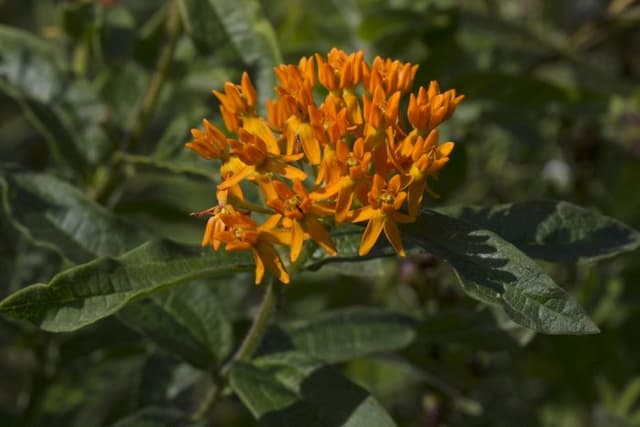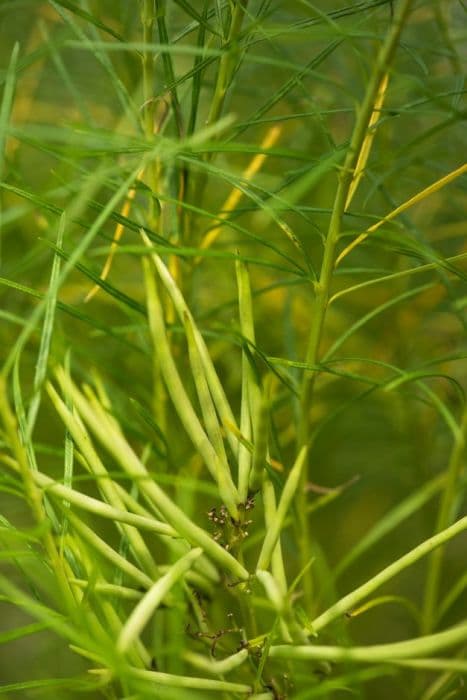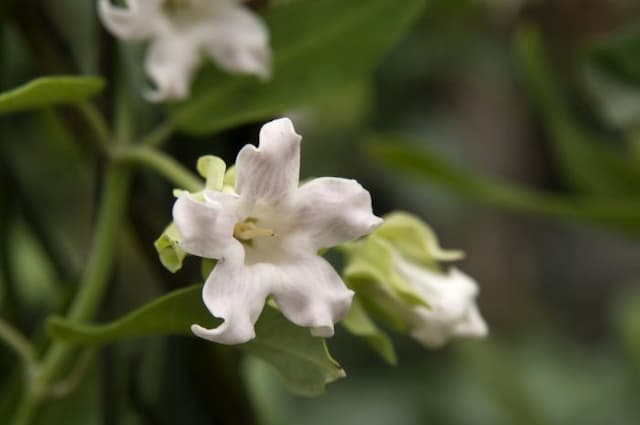Star Jasmine Trachelospermum jasminoides

ABOUT
Trachelospermum jasminoides, widely known as star jasmine, is a striking evergreen vine notable for its rich, glossy green leaves which are oval to lanceolate in shape and have a leathery texture. The foliage provides a year-round lush appearance, often arranged in opposing pairs along the plant’s stems. When flowering, star jasmine is celebrated for its profuse display of fragrant, star-shaped white blossoms. These blossoms typically have five petals and exude a sweet perfume that's especially intense during warm evenings. After flowering, the plant produces long, slender seed pods. The overall impression of star jasmine is one of an elegant and versatile plant that can create a dense, twining coverage over structures or it can be maintained as a ground cover with regular pruning to manage its spread.
About this plant
 Names
NamesFamily
Apocynaceae.
Synonyms
Star Jasmine, Confederate Jasmine, Chinese Jasmine, Trader's Compass, Confederate Jessamine.
Common names
Rhynchospermum jasminoides, Rhynchospermum jasminoides var. pubescens, Rhynchospermum jasminoides var. variegatum, Rhynchospermum reevesii, Trachelospermum difforme, Trachelospermum jasminoides var. pubescens, Trachelospermum loureiri.
 Toxicity
ToxicityTo humans
Star Jasmine, while not considered highly toxic to humans, may cause mild symptoms if ingested. These can include nausea, vomiting, and possible irritation of the mouth and throat. In general, it is not recommended to eat any part of the Star Jasmine due to these potential consequences.
To pets
Star Jasmine is also not highly toxic to pets, but similar to humans, ingestion can lead to mild gastrointestinal upset such as vomiting or diarrhea. As with most ornamental plants, it is advisable to prevent pets from eating any part of the Star Jasmine to avoid these unpleasant symptoms.
 Characteristics
CharacteristicsLife cycle
Perennials
Foliage type
Evergreen
Color of leaves
Green
Flower color
White
Height
10-20 feet (3-6 meters)
Spread
5-10 feet (1.5-3 meters)
Plant type
Climber
Hardiness zones
8-10
Native area
Asia
Benefits
 General Benefits
General Benefits- Ornamental Appeal: Star Jasmine, as it's commonly known, has glossy evergreen foliage and beautifully scented white flowers that add aesthetic value to gardens and landscapes.
- Low Maintenance: Once established, Star Jasmine requires minimal care, making it a convenient choice for busy gardeners looking for a low-maintenance plant.
- Drought Tolerance: It is relatively drought-tolerant, which is beneficial in areas with water restrictions or for gardeners looking to conserve water.
- Versatile Landscaping: Star Jasmine can be used in a variety of landscaping applications, such as ground cover, climbing vines on trellises, or potted plants for patios and balconies.
- Erosion Control: When used as ground cover, its dense growth habit can help with erosion control on slopes and banks.
- Wildlife Attraction: The fragrant blossoms attract pollinators like bees and butterflies, supporting local ecosystems.
- Year-Round Interest: Its evergreen leaves provide year-round interest and greenery, even in the winter months when other plants may be dormant.
- Privacy Screening: When trained to climb on trellises, it provides a natural green screen, offering privacy and seclusion in garden spaces.
- Climatic Adaptability: Star Jasmine is adaptable to a range of climatic conditions, thriving in both cool and warm temperate climates.
 Medical Properties
Medical PropertiesThis plant is not used for medical purposes.
 Air-purifying Qualities
Air-purifying QualitiesThis plant is not specifically known for air purifying qualities.
 Other Uses
Other Uses- Star jasmine can be used as a natural fence or living wall when trained on a trellis to create privacy or hide unsightly areas in a garden.
- The thick foliage of star jasmine can serve as a protective habitat for small birds and beneficial insects, providing shelter and a nesting area.
- Harvested jasmine flowers can be used in potpourri mixes, offering a long-lasting aroma to drawers, closets, and rooms.
- Dried jasmine flowers can be used in crafting, such as making floral arrangements, wreaths, or as decorations in handmade paper.
- The plant's glossy leaves and woody stems provide interesting textures for floral arrangements, acting as a green filler or backdrop to colorful blossoms.
- Star jasmine can be used in theme gardens, like an all-white garden, where its white flowers can contribute to the monochromatic aesthetic.
- In cooler climates, star jasmine can be grown as a houseplant, adding a decorative element with its trailing or climbing habit.
- When planted near entrances, windows, or walkways, the fragrant flowers can provide aromatherapy, potentially reducing stress and enhancing relaxation for homeowners and visitors.
- Leaves of the star jasmine can be used in art projects, such as leaf printing or stenciling, to create natural patterns and designs.
- The vines of star jasmine can be trained into various formal shapes, such as topiaries, for added landscape interest and garden art.
Interesting Facts
 Feng Shui
Feng ShuiThe Star Jasmine is not used in Feng Shui practice.
 Zodiac Sign Compitability
Zodiac Sign CompitabilityThe Star Jasmine is not used in astrology practice.
 Plant Symbolism
Plant Symbolism- Attachment: Trachelospermum jasminoides, commonly known as Star Jasmine, has the ability to cling and grow up structures, which can be symbolic of strong attachment and connection to our surroundings or loved ones.
- Purity: The white color of Star Jasmine flowers is often symbolic of purity, clarity, and innocence.
- Love: With its sweet fragrance and delicate white blooms, Star Jasmine is sometimes associated with love, sensuality, and romantic attachment.
- Beauty: The attractive appearance and scent of Star Jasmine can symbolize beauty and grace.
- Night: As the flowers are particularly fragrant at night, Star Jasmine is sometimes associated with nocturnal beauty and the mysteries of the evening.
 Water
WaterStar Jasmine should be watered thoroughly when the top inch of soil feels dry to the touch, which typically means watering approximately once a week during the growing season. The frequency of watering may reduce to every two weeks or less during the winter months when the plant is dormant. It's important to provide enough water to moisten the soil throughout the root zone. As a guideline, each watering might equate to roughly 1 gallon of water for outdoor plants or 16-24 ounces for potted specimens, depending on the size of the plant and the pot. Avoid overwatering as this can lead to root rot.
 Light
LightStar Jasmine thrives in full sun to partial shade. A spot that receives several hours of direct sunlight followed by partial shade is ideal, especially in hotter climates where some afternoon shade can protect the plant from intense heat. The plant will grow best and produce the most flowers if it receives at least 4-6 hours of direct sunlight daily.
 Temperature
TemperatureStar Jasmine performs well in a wide range of temperatures, typically between 60°F and 80°F, but it can tolerate temperatures as low as 10°F for short periods. Frost may damage the foliage or flowers, so it is advisable to protect it during severe cold snaps. The ideal growing temperature would be within the 60°F to 80°F range for optimal growth and blooming.
 Pruning
PruningStar Jasmine requires pruning to maintain its shape and encourage bushier growth. Trim it back after the plant has finished blooming, usually in late summer or early fall. Light pruning can be done throughout the growing season to remove dead or damaged growth and shape the plant. Major shaping should be reserved for after flowering to preserve the next season's blooms.
 Cleaning
CleaningAs needed
 Soil
SoilStar Jasmine prefers well-draining soil with a pH between 6.0 and 7.5. A good mix should contain peat, pine bark, and perlite in equal parts to ensure proper drainage and aeration. Fertilizing during the growing season can promote lush foliage and abundant blooms.
 Repotting
RepottingStar Jasmine does not require frequent repotting; it can be repotted every 2-3 years. It's best to repot in the spring before new growth begins, using a slightly larger pot each time to accommodate root growth.
 Humidity & Misting
Humidity & MistingStar Jasmine thrives in moderate to high humidity levels. It prefers an environment with at least 40% humidity, which encourages healthy growth and flowering. If the indoor air is too dry, using a humidifier or misting the leaves can help meet its humidity needs.
 Suitable locations
Suitable locationsIndoor
Provide bright, indirect light and consistent moisture for Star Jasmine.
Outdoor
Full sun to partial shade and protect from harsh winter winds for Star Jasmine.
Hardiness zone
8-10 USDA
 Life cycle
Life cycleTrachelospermum jasminoides, also known as star jasmine, starts life as a seed, which after finding suitable soil and environmental conditions, germinates to establish a seedling. The plant then enters a vegetative growth phase, developing a robust root system, stems, and glossy evergreen leaves in a twining vine habit. As it matures, typically within a few years, it enters the flowering stage during spring and summer, producing fragrant, white, star-shaped flowers. After pollination, these flowers develop into follicles containing seeds, which when mature, are dispersed by various means, such as wind or animal movement, to begin a new life cycle. In suitable conditions, star jasmine can also propagate vegetatively through layering or cuttings, thus bypassing the seed stage. Throughout its life, the plant undergoes repeated annual growth and dormancy cycles, allowing it to thrive for many years.
 Propogation
PropogationPropogation time
Spring to early summer
Star Jasmine, or Trachelospermum jasminoides, is commonly propagated through semi-hardwood cuttings. The most ideal time to take cuttings is during the late summer or early fall. To propagate using this method, select a healthy, semi-ripe stem about 4 to 6 inches long with several leaf nodes. Strip the leaves from the lower half of the cutting and dip the cut end into rooting hormone powder to enhance root growth. The cutting should then be placed in a container filled with a moistened mix of half peat and half perlite or sand, ensuring at least one or two nodes are buried beneath the soil surface. Cover the container with a plastic bag or place it in a propagator to maintain high humidity and warmth, avoiding direct sunlight. Roots typically emerge within 4 to 8 weeks, after which the new plant can be gradually acclimatized to ambient conditions and eventually transplanted into the garden or a permanent pot.









